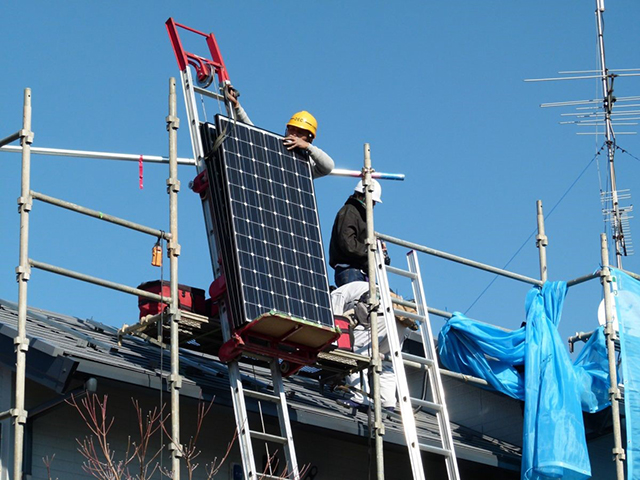
In an unprecedented move in the history of the country, Turkey has increased the share of domestic resources in electricity generation with supportive legislative frameworks and investment schemes in the last decade. As a result of the continuous efforts, the country has supplied 65% of its electricity from local resources in the last seven months, while the figure was around 50% last year, Energy and Natural Resources Minister Fatih Donmez confirmed Thursday. "The 15% rise in the share of the domestic resources in the power generation economically translates into $1.5 billion," Donmez said.
This means that Turkey's energy bill would have risen by $1.5 billion had the country not enlarged the power generation capacity of the local resources.
"All this success is the outcome of the steps we have been taking within the framework of the National Energy and Mining Policy," Donmez remarked.
National Energy and Mining Policy, a doctrine outlining the key elements of Turkish energy policy, was announced in April 2017. The policy is based on three main pillars, namely, localization, security of supply and predictability of market conditions with particular importance attached to regional infrastructural projects for diversification as a guiding element.
The policy is a broad framework explaining Turkey's plans in the energy including oil and gas explorations, mining and renewable energy investments.
The data of the energy ministry revealed that 37.3% of the total power generation came from coal plants and natural gas provided for 29.8% of the electricity generation last year. Hydroelectric power plants accounted for 19.8% while wind and solar power plants made up 6.6% and 2.6%, respectively. Geothermal power plans generated 2.5% of Turkey's electricity generation while other resources made up 1.4%.
Turkey's installed power capacity was calculated at 88,551 megawatts by the end of last year. In terms of resource types, hydroelectric power composed 31.9% and natural gas accounted for 25.6% and 21.5% came from coal. Wind and solar power made up 7.9% and 5.7% of the total installed power capacity, respectively. The remaining 5.9% came from various types of resources.
The energy minister also confirmed that Turkey's electricity imports have seen significant declines in recent years while exports are on the rise. "We have interconnection with all our neighbors. In the west, we have electricity interconnection with Bulgaria and Greece and in the east, we have interconnection with Georgia, Azerbaijan, Iran and Iraq. We had been also trading electricity with Syria in the pre-war period," Donmez said.
The minister also referred to his recent visit to Iraq, during which Turkish and Iraqi authorities agreed on electricity trade and the construction of a new oil pipeline.
In a live broadcast Thursday, Donmez also announced that the Turkish Atomic Energy Authority (TAEK) will issue the construction license for the second unit of Turkey's first nuclear power plant Akkuyu, being constructed by the Russian firm Rosatom.
In December 2018, TAEK granted the country's first nuclear power plant Akkuyu Nuclear Power Plant's (NPP) project company a "limited work permit" to construct the plant's second unit.
The licenses were issued only after fulfilling the general and special conditions, determined in accordance with the legislation on nuclear facilities. The construction of Turkey's first nuclear power plant was launched on April 3 through a groundbreaking ceremony attended by President Recep Tayyip Erdogan and his Russian counterpart Vladimir Putin.
The Akkuyu NPP holds the record for the highest investment in a single project in Turkey, with an estimated cost of $20 billion. The Akkuyu NPP will reach its full capacity in 2026 with four reactors, each with an installed capacity of 1,200 MW. It will generate an average of 35 billion kilowatt hours (kWh) of electricity annually when it reaches 4,800 MW.
The minister emphasized that the construction of the Akkuyu NPP continues as planned and the first reactor will be operational in 2023, on the centennial of the Turkish Republic.
Source: Daily Sabah

Turkey's electricity generation from wind power plants was enough to meet the country's %7.4 electricity needs in the first half of 2019, data showed.
According to the statistics of Turkish Wind Energy Association, 183 wind power plants in total were in operation while 17 more are still under construction.
Turkey currently has 3,155 wind turbines in operation.
Thus, the total installed wind capacity reached 7,615 megawatts by the end of June.
Turkish Polat Energy, Demirer Energy and Guris occupied the first 3 ranks in terms of installed wind capacity with 566,7 megawatts, 506,4 megawatts and 481,2 megawatts respectively.
Majority of the power plants are located in the Aegean and Marmara Regions of the country.
Source: Enerji Gunlugu

The government has pushed back the deadline for its £13bn smart energy meter rollout by four years to 2024 after critics said the project had “no realistic prospect” of meeting its deadline.
The government has bowed to pressure to extend the deadline after a damning report from the National Audit Office said households might be forced to pay £500m more than expected after a string of delays affecting the software underpinning the network.
Gillian Guy, the chief executive of Citizens Advice, said the deadline extension was “a commonsense move that is good news for consumers”. “It’s been clear for a long time that the 2020 deadline wouldn’t be met and today’s announcement finally recognises that reality,” she said.
Guy said the extra time would give energy suppliers the chance to fix technical problems that have dogged the programme, and for consumers to avoid aggressive sales techniques designed to persuade wary customers to have a smart meter fitted. As of June 2019, there were about 15m smart and advanced meters operating in Great Britain. In total, the programme hopes to fit up to 53m meters in homes and small businesses across the UK.
Smart Energy GB, the company set up to spearhead the smart meter campaign, said it would have liked the rollout to have been faster and easier, “but national infrastructure upgrades come with significant challenges”.
Robert Cheesewright of Smart Energy GB said it was crucial the rollout be completed because it could deliver a nearly £20bn financial benefit to Britain. “We welcome government providing a clear timetable for this. The financial and environmental benefits for households and the country far outweigh the costs by billions of pounds,” he said.
More than 85% of people with smart meters have found ways to reduce their energy consumption, according to surveys by Smart Energy GB. In addition, new energy tariffs for homes with electric vehicle chargers or solar battery systems can deliver significant savings by using the smart meter to automatically store energy when it is cheapest, to be used when market prices are high.
New analysis by the Department for Business, Energy and Industrial Strategy based on the longer time period promises slightly lower costs and a financial benefit of £19.6bn.
Ian Duncan, the minister for climate change, said the replacing of traditional gas and electricity meters was a vital upgrade to national energy infrastructure that would help the UK become a carbon neutral economy.
“We are proposing strict yearly installation targets for suppliers from 2021. This will deliver even greater benefits for households and reduce emissions,” he said.
Source: Guardian

The digital utility market is projected to grow from an estimated $135.16 billion in 2017 to $244.31 billion by 2022, at a CAGR of 12.57%, from 2017 to 2022, according to a report issued by MarketsandMarkets.
This growth can be attributed to the increase in the number of distributed and renewable power generation projects, energy efficiency mandates demanding carbon emission reduction, and strict regulatory requirements for electric utilities.
The digital utility market in Asia-Pacific is projected to grow at the fastest rate during the forecast period. Increasing investment in the electrical infrastructure and growing decentralized power generation will be driving the growth of the digital utility market in the region during the forecast period. The developing smart grid projects and investments in smart cities are also driving the digital utility market in Asia-Pacific.
Based on technology, the integrated solutions segment is estimated to grow at the fastest rate during the forecast period. The integrated solutions segment, which encompasses cloud platforms, analytics and data management, and related services, is a key aspect that enables the digital transformation of utilities. These solutions improve efficiency and productivity in the utilities sector which can drive the digital utility market.
Upcoming smart cities and the need to improve productivity and efficiency of utilities are expected to create new opportunities for integrated solutions providers and cloud platform companies in the digital utility market. Utilities are also focusing on deploying digital technologies in restructuring their businesses. All these factors will drive the digital utility market during the forecast period.
The market in North America is currently the largest market for digital utility, closely followed by the European market. Rising investments in aging electrical infrastructure and increasing electricity demand are driving the digital utility market in the North America. The market in the U.S. is estimated to be the largest in the region, followed by the markets in Canada and Mexico, during the forecast period.
Source: Smart Energy International

With the region of Styria considering making PV mandatory on all new buildings, the nation’s Climate Fund will support PV and storage projects in agriculture and forestry. Applications can be submitted by November 2020 – or until the pot is empty.
The regional government of Styria, in southern Austria, is considering a housebuilding reform package which could make PV systems mandatory on the roofs of new buildings.
The policy package proposes mandating building design which would support a kilowatt of solar generation capacity for every unit of roofspace.
The news comes as the Austrian Climate Fund this week opened a rebate scheme for PV and energy storage systems used in agriculture and forestry. The program will offer subsidies for PV systems with a 5-50 kW capacity and for storage systems with a capacity in kilowatt-hours up to three times the generation capacity of the rooftop array.
Backed by a €6 million budget, which may increase next year, applications for subsidy can be made until November 20 next year – or until the funds run out.
“Only newly installed photovoltaic systems – with and without electricity storage – as well as electricity storage as retrofitting for existing photovoltaic systems will be subsidized,” stated the Climate Fund. “The installation of used PV modules and used power storage is not encouraged.”
The subsidy available is €275 per installed kW and €375 for building-integrated PV systems. For storage systems the rebate available per kilowatt-hour of usable capacity ranges from €350 for the smallest units – with a capacity up to 5 kWh – to €250 for the largest (20 kWh and above).
Applications must be submitted online and payments will be made after project installation.
Federal association Photovoltaic Austria (PVA) welcomed the new fund. “Especially for electricity storage systems, the investment costs per kilowatt-hour decrease with increasing storage size. Therefore, the staggering of the subsidy rate depending on the storage size guarantees a very efficient use of the subsidies,” said PVA managing director Vera Immitzer.
The Climate Fund in Austria also promotes the general installation of small PV systems, with a capacity of up to 5 kW. High demand means the subsidy budget has already been raised several times this year and amounts to more than €8 million. The PVA has criticized the process of augmenting the budget and said supplying sufficient funds to start with would allow applicants to plan better.
Source: PV Magazine

Investors managing assets worth $35 trillion are sending a message to governments and companies: Do more to fight climate change.
A group of 515 investors on Wednesday urged policymakers to act with the "utmost urgency" to comply with the goals of the 2015 Paris climate agreement, which seeks to limit global warming.
"Much more needs to be done by governments to accelerate the low carbon transition and to improve the resilience of our economy, society and the financial system to climate risks," the investors said in a statement ahead of next week's United Nations Climate Action Summit.
Signatories to the statement include some of the world's biggest pensions funds and asset managers, including the California Public Employees' Retirement System, UBS Asset Management, Allianz Global Investors and Nomura Asset Management.
The group urged governments to phase out thermal coal power and fossil fuel subsidies, and set a price for carbon emissions. They called on companies to provide more information on climate risks.
The investors control nearly half of the world's invested capital, giving them significant influence over the companies and governments best positioned to combat climate change, organizers said.
"With the immense power and influence that investors hold in our global economy, they have a tremendous opportunity and responsibility to act at the urgent pace and scale required," said Mindy Lubber, CEO of Ceres, a sustainability nonprofit founded in the aftermath of the 1989 Exxon Valdez oil spill in Alaska, that helped to organize the campaign.
United Nations Secretary General Antonio Guterres has asked governments to present more ambitious climate change plans at a summit on Monday. The goal is to cut greenhouse emissions by 45% by 2030, and to achieve carbon neutrality by 2050.
"I am also asking all investors to scale up green ventures, to increase lending for low-carbon solutions and to stop, in effect, financing pollution," he said in June.
A second group of investors managing $15 trillion in assets warned Wednesday that energy companies are not doing nearly enough to reduce carbon usage.
Only 31 of the top 109 energy companies are aligned with the pledges made by national governments in Paris, the Transition Pathway Initiative said. The climate agreement signed there in 2015 seeks to limit the global average temperature increase to well below 2 degrees Celsius just two oil and gas companies — Royal Dutch Shell (RDSA) and Repsol (REPYY) — are aligned with the Paris goals, the group said.
"This new research shows the energy sector is inching rather than accelerating towards a low-carbon future. It is not quick enough," said Adam Matthews, the co-chair of the Transition Pathway Initiative and director of ethics and engagement at the Church of England Pensions Board.
Source: CNN International
The Speed of Energy Transition
The energy industry is complex, and understanding the major trends changing the industry can be challenging. Investors, policy makers, business people, and other interested stakeholders require clear information about the evolution of the energy system to inform present decisions, which can have long lasting impacts. A key issue for the 2020s is whether the energy transition will be gradual or rapid. A gradual transition means that we miss the goals of the Paris Agreement, but energy sector incumbents can continue to flourish. A rapid transition means we have a chance of hitting the goals of the Paris Agreement, but incumbents will be disrupted by the speed of change.
Please click here to read the full report.
Turkey Energy Forum
October 02 - 03 / Shangri La Bosphorus, Istanbul
Turkey Energy Summit
October 06 - 08 / Antalya
12. International Energy Congress- EIF
November 06 - 08 / Ankara
European Utility Week
November 12 - 14 / Paris
1. International Energy Summit 2019
November 21 - 24 / Antalya

